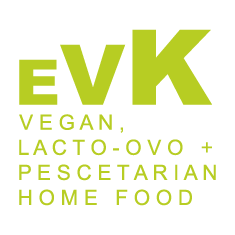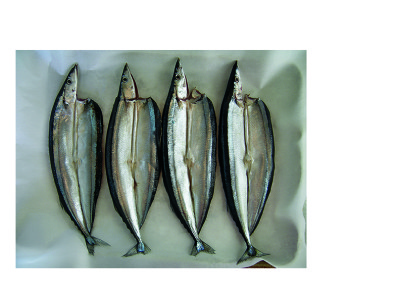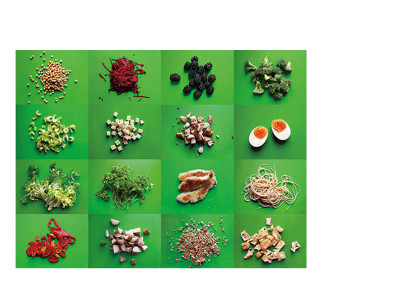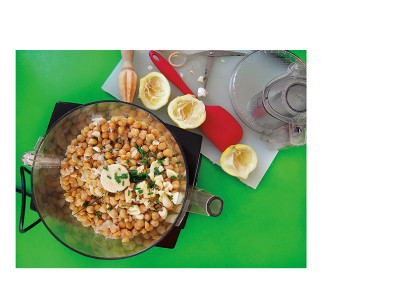OUR TOP 24 SUPERFOODS!
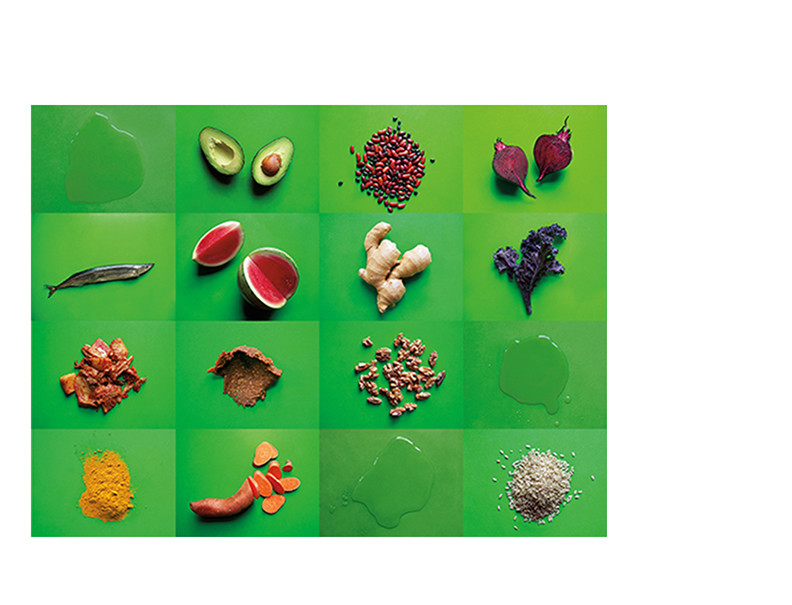
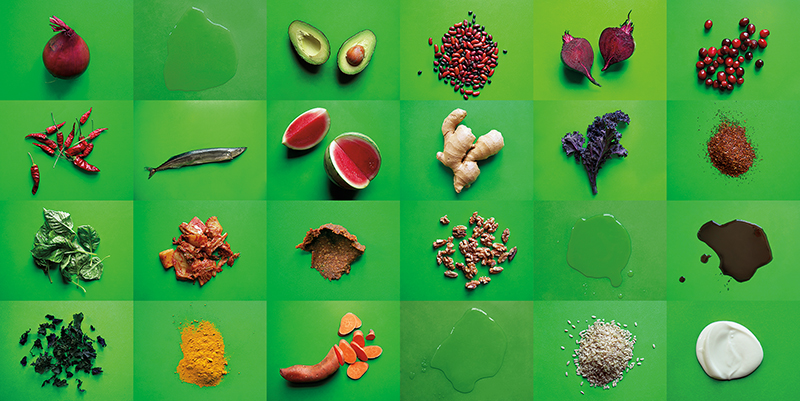
Every culture has its superfoods that support the nutrition of its people. Now that many of these foods are widely known + available in Vancouver, we at EVK try to incorporate as many of them as possible into our meals!
Nutritional information is always changing, + experts do not always agree: somebody’s hero food is often somebody else’s villain! With that in mind, we present OUR top 24 superfoods, backed by sources we consider unbiased, reputable + accessible. We’re not scientists, doctors, or nutritionists, + this is not a definitive list for all time: this is for day-to-day cooking + hopefully enjoying a rich + prolonged life!
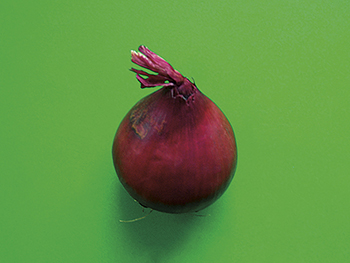
Alliums
CHIVES, GARLIC, LEEKS, ONIONS, SCALLIONS, SHALLOTS, ETC.
We are pro-GARLIC because it’s so good at being anti-: anti-bacterial, anti-biotic, anti-septic. Thanks to these qualities, eating garlic may reduce blood pressure, + thus, heart disease + stroke risk. Chop or mash your garlic + allow it to sit on the cutting board away from heat for about 10 minutes. This exposure to air allows the active component of garlic- allicin- to form. Consider swallowing two small cloves whole at the first sign of a cold! source: drweil.com
Raw ONIONS sting your eyes because of their sulphur compounds- but that’s also what gives them their strong flavor! Eat the layers as close to the skin as possible, as that’s where the other good guys- the anti-oxidant flavonoids- live, which can protect against cell damage, + possibly ease asthma + allergy symptoms. source: Blythman, Joanna. What To Eat: Food That’s Good For Your Health, Pocket + Plate. London: Fourth Estate. 2012.
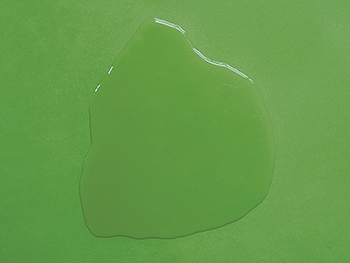
Apple Cider Vinegar
This is our #1 superfood! A shot of organic, unpasteurized, APPLE CIDER VINEGAR diluted in a glass of water is a traditional remedy for many ailments, including arthritis, high blood pressure + diabetes. ACV can also promote detoxification by encouraging the production of bile in your liver; rid the body of overgrown candida; alkalize your body’s pH; + aid digestion by encouraging friendly intestinal bacteria. It’s also great for easing heartburn! It can also be used externally to strengthen your hair, cleanse + tone your skin, + soothe sunburns. Be sure to buy unpasteurized ACV with ‘the mother,’ that filmy substance floating around in the bottom of the bottle. The presence of the mother tells you that the bacteria, enzymes + protein in your vinegar are still alive! source: pacificcollege.edu (Pacific College Of Oriental Medicine)
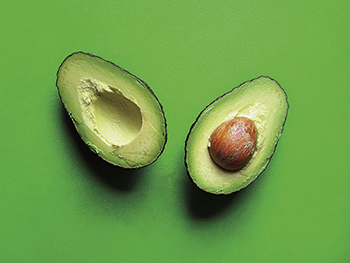
Avocados
AVOCADOS contain mono-unsaturated fat, which can lower LDL (bad) cholesterol, as well as lots of fiber, folate + more potassium than a banana! The smooth texture of this fruit can be a great replacement for other fats on your sandwiches, such as butter or mayo. Consider using avocado oil instead of olive oil for frying- it has a higher smoke point, + is a great source of vitamin E! source: healwithfood.org

Beans
BLACK BEANS, CHICKPEAS, LENTILS, RED BEANS, SOY BEANS, ETC.
Of all legumes, BLACK BEANS are the richest in anti-oxidants, as they share the same compounds found in dark red fruits. High in folate + magnesium, they’re also great for your heart! source: drweil.com
Insoluble fibre: it keeps everything moving! + CHICKPEAS (GARBANZO BEANS) contain a lot of it! You’ll also find high amounts of folate + manganese in chickpeas, making them a great way to support heart + respiratory health! source: drweil.com
Very high in protein + iron, LENTILS may have been one of the first crops cultivated by humans! Choose your lentil type with your recipe in mind: red, yellow + brown lentils work best in soups, dhals + curries, as they will seem to melt into a delicious soupy texture. French green lentils (aka le puy) are great for salads, as they tend to hold their shape after cooking. source: drweil.com
RED (KIDNEY) BEANS contain serious fibre + protein, + can easily be added to salads or soups to boost your intake of both. Note that raw, dried red beans must be boiled for at least 10 minutes before they can be used in a slow cooker, or added to stews or soups- nor can they be sprouted, like many other beans, as they contain a toxin called phytohemagglutinin. source: drweil.com
Whole soy foods use the whole SOY BEAN– meaning our bodies can get at the complete proteins, fibre, minerals (zinc, magnesium, iron + selenium) they have to offer. Try edamame, miso, tempeh, tofu, soy nuts + soy milk or yogurt. Plant based proteins are great way to go a little easier on the planet with your food choices! source: Warber, Sara, PhD. “Healing Foods Pyramid: Whole Soy Foods. The University of Michigan Health System. 2009. Web. 10 July 2015.
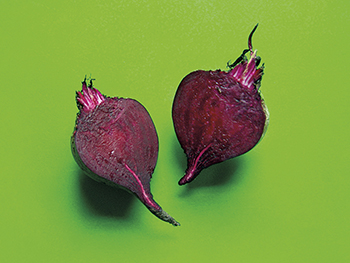
Beets
BEETS are beautiful! They provide fibre, folate, calcium + magnesium, but what’s really special about them is that they contain a compound called betaine, which can help you get through the winter by having anti-oxidant, anti-inflammatory + detoxification effects. Steam or roast them to break down cell walls + release their anti-oxidants! source: Beck, Leslie. “The Four Local Vegetables That Will Get Your Through Winter.” The Globe And Mail, Jan. 6, 2014. Web. 10 July 2015.
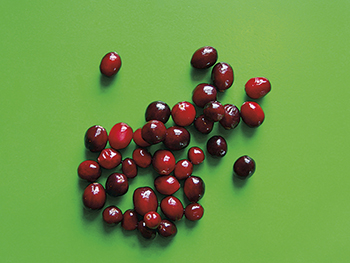
Berries
ACAI BERRIES, BLACKBERRIES, BLUEBERRIES, CRANBERRIES, GOJI BERRIES, RASPBERRIES, STRAWBERRIES, ETC.
BLUEBERRIES have properties that may help your body defend itself against cancer, heart disease + the degenerative illnesses of aging. A source of vitamin C, they can also help you stay alert. Spring for organic- they’ve got more of all of the above! source: Blythman, Joanna. What To Eat: Food That’s Good For Your Health, Pocket And Plate. London: Fourth Estate. 2012.
CRANBERRIES are small but very powerful: their anti-oxidant, anti-inflammatory + anti-bacterial properties can help guard against hardening arteries, stomach ulcers, dental plaque + even certain cancers. This is without even mentioning their high levels of vitamin C + fibre. Drink a good quality, unsweetened cranberry juice to help fight off a urinary tract infection source: lesliebeck.com
Like many other berries, GOJI BERRIES are a great source of beta-carotene, + are a good source of fibre + vitamin C. What’s special about them is their anti-oxidant properties, which can help prevent the cell damage that can lead to cancer + many other diseases. source: lesliebeck.com
The ideal local berry combo, RASPBERRIES + BLACKBERRIES contain vitamin C + K, fibre + anti-oxidants, so they are real immune + heart helpers. As a source of ellagic acid, they also may be able to rid the body of carcinogens. source: healwithfood.org

Chiles
CAYENNE PEPPERS, JALAPEÑOS, HABANEROS, PIRI PIRIS, POBLANOS, THAI CHILIES, ETC.
CHILIES are hot because they contain capsaicin, which is found mostly in the seeds, + has anti-inflammatory properties. Like many fruits + veggies, the brighter the colour of the chili, the more vitamins it contains- in this case, A, C, + E + potassium. source: lesliebeck.com

Fish
ANCHOVIES, HALIBUT, HERRING, MACKEREL, RAINBOW TROUT, SALMON, SARDINE, SAURY, ETC.
HALIBUT is a firm fleshed, rich tasting white fish that is beautiful grilled lightly with some pineapple! It is also an excellent source of calcium, iron, zinc, thiamin, riboflavin, folate, magnesium, phosphorus, selenium, niacin, + vitamins A, B6 + B12! source: lesliebeck.com
HERRING is a very good source of vitamin D which strengthens teeth + bones. It also contains EPA (eicosapentaenoic acid) + DHA (docosahexaenoic acid), fatty acids which help prevent heart disease, aid brain function + possibly reduce inflammatory conditions, such as Crohn’s disease + arthritis. source: Blythman, Joanna. What To Eat: Food That’s Good For Your Health, Pocket + Plate. London: Fourth Estate. 2012.
RAINBOW TROUT is an excellent source of two omega-3 fatty acids- DHA + EPA, which are credited with preventing heart disease. DHA is also very important for brain health: it actually makes up 60% of the membranes in the brain, keeping them fluid so that memory-related messages can pass between brain cells. Rainbow trout is also a significant source of vitamin B12, which is great for the nervous system! source: lesliebeck.com
Wild caught, local SALMON is so beautiful! + As a cold water, oily fish (like MACKEREL, SARDINES + HERRING), it’s a great source of omega-3 fatty acids, which help support brain + heart health. source: drweil.com
SARDINES are the best, low-on-the-food chain source of omega-3 fatty acids: you can easily add these to your diet by grilling lightly with salt + lemon, or water-packed in a can! source: drweil.com
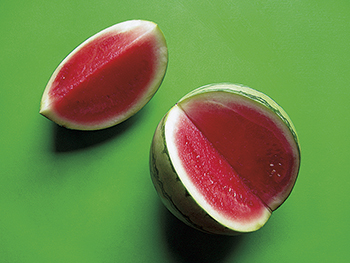
Fruit
APPLES, BANANAS, CHERRIES, GRAPEFRUITS, LEMONS, LIMES, ORANGES, RED PEPPERS, TOMATOES, WATERMELON, ETC.
CHERRIES are very special: they are lower in sugar than many other fruits + they are also one of the few foods that contain the sleep hormone melatonin. Choose the tart ones, like morellos, for even higher levels of melatonin! source: Blythman, Joanna. What To Eat: Food That’s Good For Your Health, Pocket + Plate. London: Fourth Estate. 2012.
Half a GRAPEFRUIT will give you half of the day’s vitamin C! Like tomatoes, grapefruits contain lycopene, which may also prevent heart disease. source: lesliebeck.com
First of all, LEMONS are so high in vitamin C that one cup of lemon juice contains 100% of your recommended daily intake! Secondly, citrus fruit cells contain limonins, which may reduce the incidence of mouth, skin, breast, stomach + colon cancers. Finally, lemons can stimulate the liver for detoxification. That’s why we’re drinking lemon water as we write this! source: lesliebeck.com + drweil.com
TOMATOES contain an anti-oxidant called lycopene. Unusually for food nutrients, lycopene from tomatoes will be absorbed better if it’s been heated or cooked- which is why canned tomatoes + even ketchup still retain their health benefits! Tomatoes also contain serious vitamin C, E + K, which seem to work together to reduce heart disease. source: Blythman, Joanna. What To Eat: Food That’s Good For Your Health, Pocket + Plate. London: Fourth Estate. 2012.
Like tomatoes + grapefruit, WATERMELON is an excellent source of lycopene, an anti-oxidant which may help to prevent heart disease + prostate cancer. Plus, a single wedge will deliver a third of your recommended day’s intake of vitamins A + C! source: Fiegl, Amanda. “Five Reasons to Eat Watermelon.” National Geographic Society, 20 Aug. 2013. Web. 10 July 2015.
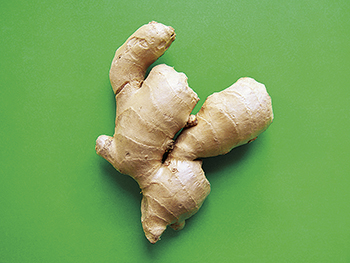
Ginger
GINGER is known for its soothing, anti-inflammatory qualities which can aid digestion + reduce the effects of travel sickness + flu symptoms. For a helpful cold + flu remedy, thinly slice ginger + boil with a chili for 10 minutes or so. Allow to cool somewhat, strain out solids + serve with lemon juice + honey. source: Blythman, Joanna. What To Eat: Food That’s Good For Your Health, Pocket + Plate. London: Fourth Estate. 2012.
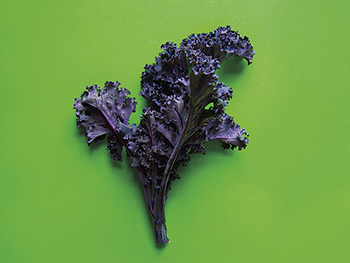
Greens + Cruciferous Veg
BOK CHOY, BROCCOLI, BRUSSELS SPROUTS, CABBAGE, CAULIFLOWER, KALE, SPINACH, SWISS CHARD, ETC.
CRUCIFEROUS VEGETABLES, like BROCCOLI, CAULIFLOWER + BRUSSELS SPROUTS, contain compounds which may help reduce the chances of getting cancer by getting rid of carcinogens. Eat raw or lightly steamed for best results! source: Beck, Leslie. “The Four Local Vegetables That Will Get Your Through Winter.” The Globe And Mail, Jan. 6, 2014. Web. 10 July 2015.
Look for BOK CHOY with more green leaves than white stem: the leaves contain carotenoids, which help protect your eyes from the aging process. High in vitamin C, eating lightly steamed bok choy can improve skin, bone, cardiovascular + dental health, + may improve the ability to absorb iron from foods. It’s also high in vitamin K, which is important for bone + cardiovascular health! source: healwithfood.org
BROCCOLI brings a lot to the table: it contains compounds that are likely to help fight cancer + reduce heart disease-causing inflammation. It also contains the vitamins C, K + folate, that help strengthen your immune system. source: Blythman, Joanna. What To Eat: Food That’s Good For Your Health, Pocket + Plate. London: Fourth Estate. 2012.
Of all the local winter veg, CABBAGE is the most powerful source of vitamin C, but it’s also great for providing fibre, calcium, potassium, folate + vitamin K! source: Beck, Leslie. “The Four Local Vegetables That Will Get Your Through Winter.” The Globe And Mail, Jan. 6, 2014. Web. 10 July 2015.

Green Tea + Infusions
HIBISCUS, ROOIBOS, ROSE HIP, WHITE TEA, YERBA MATÉ, ETC.
GREEN TEA is thought to protect the brain against forms of dementia including Alzheimer’s, + the body against cancer. A cup of green tea with a squeeze of lemon juice is an excellent way to start things off in the morning! source: Blythman, Joanna. What To Eat: Food That’s Good For Your Health, Pocket + Plate. London: Fourth Estate. 2012.
Originally from Paraguay, MATÉ has traditionally been brewed with hot water in a gourd + drunk through a silver straw. It’s a great morning pick-me-up, as it contains a stimulant similar to that found in chocolate + tea, but won’t leave you feeling jittery or in a rut the way caffeinated hot drinks can. There is also some evidence that the anti-inflammatory properties of maté can help prevent colon cancer. source: drweil.com
Actually a legume, not a tea plant, ROOIBOS is high in anti-oxidants, caffeine-free – + possibly cancer preventing. Stay tuned for more research in this area! source: Carroll, Rory. “Special Brew.” The Guardian. 31 Aug. 2004. Web. 10 July 2015.
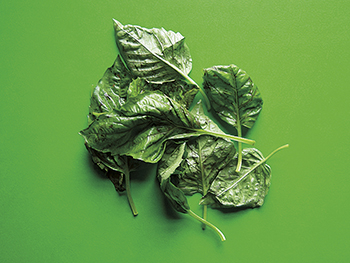
Herbs
BASIL, OREGANO, PARSLEY, ROSEMARY, SAGE, ETC.
In addition to adding a fresh + spicy flavor to food, BASIL is a good source of vitamin A, magnesium, iron + calcium. source: drweil.com
That stem of PARSLEY on your plate at the diner isn’t just decorative! Eating it at the end of your meal will freshen your breath + help reduce bloating. It’s also a great source of anti-oxidants, folic acid, + vitamins A, C + K. source: drweil.com
OREGANO may seem like your average pasta sauce ingredient, but it should be taken seriously as a great source of anti-oxidants, vitamins K + E, manganese, iron + calcium! Its oil is also anti-bacterial- next time you feel a cold coming on, take a few drops of oil of oregano in a glass of water! DO NOT TAKE OIL OF OREGANO IF YOU’RE PREGNANT! source: drweil.com
ROSEMARY contains rosmarinic acid, a plant polyphenol with anti-oxidant + anti-inflammatory properties, which may help reduce inflammation of the joints. source: healwithfood.org
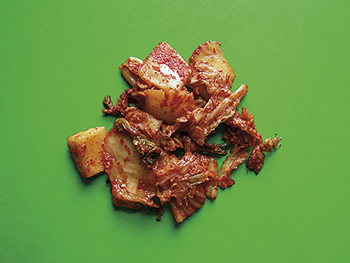
Kimchi
KIMCHI is a traditional Korean side dish often made from fermented cabbage, radish, green onions + chili. It’s hot + vinegary, + wonderful with fried eggs + rice in a breakfast bowl! Consider eating one type of fermented food daily- it will help you develop a healthy intestinal flora by building up a diversity of beneficial bacteria types. This can include kimchi, kefir, yogurt, sauerkraut or fermented pickles. source: drweil.com
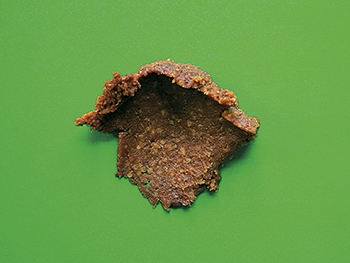
Miso
MISO delivers two things really well: protein + the probiotics that are so good for digestive health, such that many credit it as a life-extension food. Consider a bowl of miso soup for brekky (never boil it!), or using miso paste in salad dressing, cashew sauce or veggie gravy. Note that miso is quite high in sodium, so consider eating it regularly but in small doses! source: drweil.com
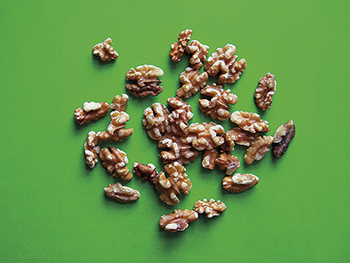
Nuts + Seeds
ALMONDS, BRAZIL NUTS, CASHEWS, CHIA SEEDS, FLAX SEEDS, HAZELNUTS, HEMP SEEDS, PUMPKIN SEEDS, QUINOA, SESAME SEEDS, WALNUTS, ETC.
ALMONDS are a rich source of vitamin E + mono-unsaturated fats, thought to protect the skin (against UV light damage), brain (against Alzheimer’s disease) + heart (against heart disease). They also contain manganese, good for bone strength + blood sugar regulation; + magnesium, aiding organ function + blood pressure. Eat almonds with their skin on for maximum vitamin E! source: Blythman, Joanna. What To Eat: Food That’s Good For Your Health, Pocket + Plate. London: Fourth Estate. 2012.
CHIA is a serious heavy-hitter as a plant-based source of omega-3 fats, the same fatty acids found plentifully in fish oils. This means they’re great for heart health + for reducing inflammation. On the anti-oxidant front, they even top blackberries! + On the mineral front, they supply calcium-magnesium, copper, iron, manganese + zinc- all powerful helpers for bone + nervous system health. Chia also contains vitamin B’s which help to metabolize carbs, fats + protein; + fiber, aiding cardiovascular + digestive health. source: healwithfood.org
FLAX SEEDS are A) very high in alpha-linolenic acid, + B) the highest source of lignans of all foodstuffs! This means that A) they contain a type of omega-3 fatty acid that is considered very likely to protect against heart disease, + B) they are likely to protect against hormone-sensitive cancers, such as prostate, ovarian + breast cancer. Grind them up + sprinkle a couple of tablespoons on your hot cereal in the morning! source: lesliebeck.com
TREE NUTS like HAZELNUTS contain vitamin E, mono-unsaturated fats, + minerals like copper + magnesium. Eating tree nuts is thought to reduce blood pressure + inflammation, + thus, the risk of cardiovascular disease. source: Blythman, Joanna. What To Eat: Food That’s Good For Your Health, Pocket + Plate. London: Fourth Estate. 2012.
HEMP SEEDS contain alpha-linolenic acids, a kind of omega-3 fatty acid similar to those found in fish oil. Not only is this good news for vegans, but these particular fatty acids may help prevent heart disease + cancer. Hemp seeds are also very high in vitamins A, C + E, beta-carotene, protein, carbohydrates + fibre. Add some to a smoothie or sprinkle on a salad! source: drweil.com
QUINOA is full of fibre + essential minerals like magnesium + phosphorus. It’s easy to digest + can be added to your rice or hot cereal mix, or served on its own as a light substitution for rice or bulgur! source: healwithfood.org
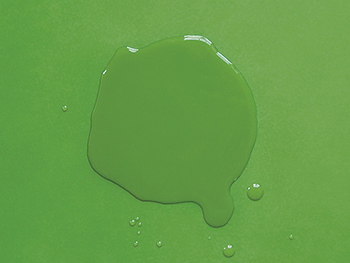
Olive Oil
OLIVE OIL contains very high levels of mono-unsaturated fat- the highest of all edible oils, which means it can reduce LDL cholesterol levels in the blood while maintaining healthy HDL levels. That means consuming olive oil can reduce the risk of heart disease. When cooking with olive oil, choose high quality, certified organic extra virgin olive oil + avoid high temperatures as olive oil has a lower smoke point than some other cooking oils! source: drweil.com
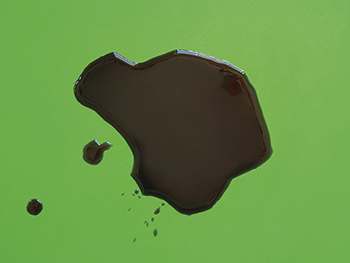
Red Wine
Two glasses of RED WINE a day sounds great for lots of reasons- not the least of which is the chance to sit down together in the evening + talk about how our days went! But real science doctors have said that moderate drinking may reduce the chances of blood clot formation in coronary arteries, + may increase levels of the ‘good’ type of cholesterol (HDL). source: drweil.com
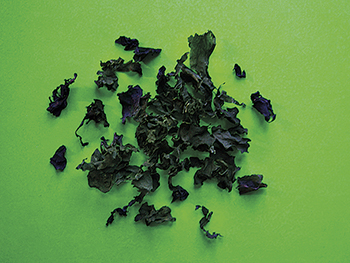
Seaweed
ARAME, HIJIKI, KELP, KOMBU, NORI, PURPLE LAVER, WAKAME, ETC.
SEA VEGETABLES, such as the seaweeds ARAME + WAKAME, are high in minerals, + PURPLE LAVER contains high levels of the B vitamins. If harvested from a clean source, sea vegetables can help you rid your body of environmental toxins such as cigarette smoke + industrial pollutants. source: Blythman, Joanna. What To Eat: Food That’s Good For Your Health, Pocket + Plate. London: Fourth Estate. 2012.

Spices
ANISE, CAYENNE, CINNAMON, CLOVES, PAPRIKA, SAFFRON, TURMERIC, ETC.
As a dried chili pepper product, CAYENNE contains the heat-producing compound capsaicin, which has anti-inflammatory properties, + is a great source of vitamins A, C, + E! As a red chili pepper product, cayenne also contains the anti-oxidant beta-carotene, making it helpful for repairing the cell damage caused by free radicals. Sprinkle some (carefully!) on anything that needs a kick: soups, chili, even hot chocolate! source: drweil.com
The benefits of consuming CINNAMON’s essential oils are various: as an anti-microbial, they may help stop the growth of bacteria + fungi, as well as the yeast candida. Cinnamon may also be a good way to control blood sugar + reduce LDL cholesterol, as well as improve mental focus. Consider brewing your morning coffee with a stick of bark, or sprinkling fresh powdered cinnamon on your hot cereal! source: drweil.com
PAPRIKA packs a serious amount of vitamin E! Try sprinkling on top of your hummus, baked potatoes, or shepherd’s pie, or use it to heat up your soups + chilies! source: healwithfood.org
TURMERIC contains curcumin, a powerful compound thought to inhibit cancer cell growth + the inflammation of rheumatoid arthritis. Usually consumed in powder form, the fresh root can also be peeled + juiced to supercharge a morning juice! source: Blythman, Joanna. What To Eat: Food That’s Good For Your Health, Pocket + Plate. London: Fourth Estate. 2012.
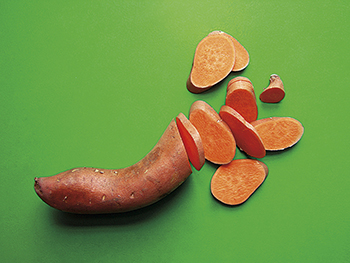
Sweet Potatoes
SWEET POTATOES grow in orange, yellow, white + purple varieties. Stick with the orange ones! Orange sweet potatoes are higher in beta-carotene than carrots + higher in vitamin C than tomatoes! Beta-carotene is converted into vitamin A when digested, improving wound healing, bone health, + the transport of calcium around the body. High levels of vitamin C give orange sweet potatoes powerful anti-oxidant properties which can help protect against cancer. Sweet potatoes also have a low glycemic index- the carbohydrate they contain is released into the body slowly- no sugar rush, no crash later on! Roast, or boil + mash as a nutritionally rich side dish! source: Beck, Leslie. “The Four Local Vegetables That Will Get Your Through Winter.” The Globe And Mail, Jan. 6, 2014. Web. 10 July 2015.
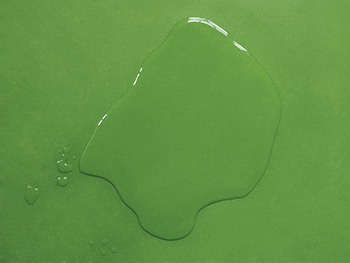
Water
Fresh WATER is the most precious substance on the planet! About 70% of the earth’s surface is covered in water but only 2.5% of that water is fresh; + more than half of that is unavailable, largely frozen in glaciers + snow fields, leaving about 1% of the earth’s water available for everybody on the planet! At birth, the human body is made up of about 78% water, reducing to between 55% for women + 60% for men in adulthood. To replace the water we use in a day, women need to take in 2.2 Litres of water each day, men need closer to 3 litres, some of which is available through food. The human body can only go 3 days without drinking water- so stay hydrated, friends! source: usgs.gov/water, “Clean Water Crisis, Water Crisis Facts, Water Crisis Resources.” National Geographic Society, 20 Aug. 2013. Web. 10 July 2015.
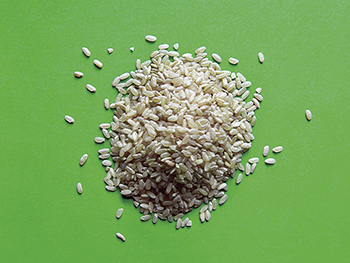
Whole Grains
AMARANTH, BROWN RICE, BUCKWHEAT, KAMUT, OATS, SPELT, ETC.
AMARANTH is an excellent source of calcium, protein + essential minerals such as iron, zinc, magnesium + potassium. Gluten-free, it also has triple the fibre of wheat! Add amaranth flakes to your morning hot cereal! source: healwithfood.org
Concerned about allergies? Don’t worry- BUCKWHEAT isn’t related to wheat, nor does it contain gluten. There’s even some evidence that buckwheat is an hypoallergenic food, meaning that eating it, either as groats (for a nice couscous or bulgur replacement) or in your hot cereal mix, can inhibit histamine release, thereby reducing other allergic reactions. source: healwithfood.org
Manganese: BROWN RICE (a whole grain, with its outer bran + germ layers intact) contains loads of it! This is important as this mineral aids in fatty acid synthesis + protects against free radical damage, improving bone development + wound healing. Plus, rice of all types is gluten-free, lowers cholesterol + is very healthy for digestion! source: drweil.com
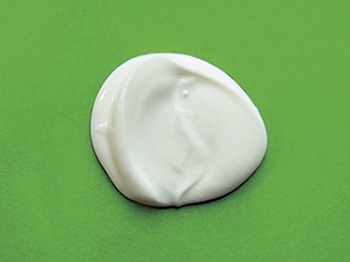
Yogurt + Kefir
Organic dairy YOGURT contains lactic bacteria which support the immune + digestive systems. If the yogurt separates, mix the whey back in- that’s the protein! source: Blythman, Joanna. What To Eat: Food That’s Good For Your Health, Pocket + Plate. London: Fourth Estate. 2012.
A couple of spoonful’s of KEFIR in the morning will help you maintain a lively intestinal flora, which is key for digestive health. It’s also a great source of calcium + protein! source: lesliebeck.com
